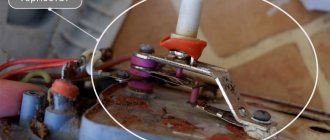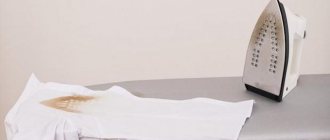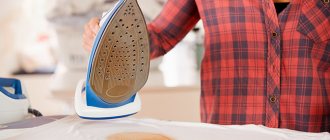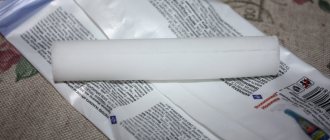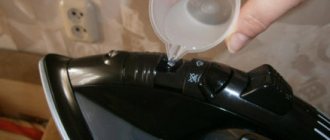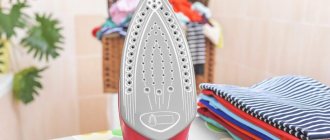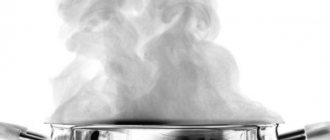This invention is an excellent assistant, which is available for purchase in any store and is often recommended to be purchased immediately along with an iron, so that it is at hand when a situation arises with a dirty sole.
What is a pencil?
A pencil is a special device for cleaning an iron. It is an object in the form of a candle (lipstick). Its consistency is quite hard and leaves a mark when pressed. Hence the name - pencil. Thanks to the special chemical composition, you can clean the iron with a pencil from carbon deposits, deposits, and scale.
It is produced by domestic and foreign manufacturers. The composition is approximately the same. It includes:
- bleaching agents (citric acid or soda);
- aromatic fragrances (berry, fruit, floral notes);
- Ammonium nitrate.
The shape resembles a light-colored cylinder up to 10 centimeters long and 2-3 centimeters in diameter. It can be packaged in a cardboard case or be unpackaged and sold in a plastic bag.
The price depends on the popularity of the manufacturer. Domestic products can clean carbon deposits no worse than foreign ones, but they are cheaper.
Methods for cleaning durable coatings
When cleaning durable titanium, steel, sapphire and enamel coatings, even aggressive and abrasive agents can be used.
To clean irons with these types of soles, you can use a powder or toothpaste that contains abrasive particles. The device needs to be warmed up a little. The surface should be warm, but not hot. Use a brush, onto which 2-3 cm of paste is previously applied, to clean the sole. The surface is wiped with a damp cloth to remove any remaining paste. Then it is thoroughly rubbed with a dry cloth.
In addition, heavy carbon deposits can be removed with a mixture of soda and detergent in a 2:1 ratio. The gruel is applied to a cold surface. Then the surface is cleaned with a sponge. Remains of product and dirt are removed with a damp cloth.
Durable surfaces can be cleaned with salt. To do this, salt is poured onto the cotton fabric so that it is completely covered. Then you need to warm up the device as much as possible and place its sole on the salt. After 2-3 minutes, you should remove the parting, brush off the stuck salt, and then iron it with a stiff cotton cloth. For better results, all steps must be repeated.
If carbon deposits on the surface are caused by contact with synthetics, the contamination can be removed using another aggressive method. First, the remains of burnt synthetics should be cleaned off the heated surface. Then, with the device heated to maximum, you should iron the old, rough towel. This will remove any remaining contamination.
How to use it
If you own a device with a Teflon sole, then it is better to clean the iron with a pencil that is specially designed for non-stick coating. It contains no large particles that can scratch such a unit.
The instructions for all manufacturers are almost the same:
- Turn on the device and wait until it warms up.
- Place it vertically, with the sole facing you.
- Apply the product over the surface of the sole. You will see that it leaves a mark. The sole should be covered evenly with the mixture. There should be no clean areas.
- Turn off the iron and let it cool.
- Wipe the device with a dry cloth or napkin, removing the melted product completely.
Repeat the action if necessary, but this is usually not necessary.
Remember, the iron may smoke a little when applying the product. There's nothing wrong with that.
Attention! Do not delay cleaning the product from the surface of the iron. Clean the mixture immediately after the appliance has cooled down.
Otherwise, the dried mass will not be easy to remove.
Your iron is ready to use and looks like new!
How to clean carbon deposits from an iron at home?
Laundry soap was previously used for these purposes. To remove carbon deposits, the hot sole was rubbed with laundry soap, and then the dirt was removed with a rag, making considerable effort. Another way is salt. It was poured onto a sheet of paper, and then a hot iron was passed over it, pressing it tightly. This option is only suitable for steel soles.
And one of the most common folk methods of dealing with blockages in the steam holes of the iron was considered and is still chosen by many housewives - citric acid. To do this, it is mixed with water and poured into the iron. Then they heat it to maximum temperature, let it cool, then heat it up again and press the “steam” button, citric acid punches holes, eliminating contamination.
Of course, such cleaning methods also exist and are still used by many housewives. But, if you always have an iron pencil at hand, the cleaning process can be made faster and more effective.
Pros and cons of using it
- Availability - the pencil is sold in any store with household chemicals.
- Cost-effective - a pencil costs little - for 35-40 rubles you can buy an excellent product for cleaning an iron.
- Efficiency - it removes even old carbon deposits. There is no need to purchase additional care products.
- Easy to use - the pencil is easy to use, it is a ready-to-use tool. Simply apply it to a hot iron.
Many people fear that when heated, dangerous substances are released that can poison a person. But modern technologies allow manufacturers to use safe ingredients that do not harm health.
Material
Today, irons are produced with different functions and coatings - ceramic, titanium, Teflon, with aluminum and stainless steel soles. But even the most “fashionable” and ultra-modern iron can suffer if it is not properly cared for.
Modern materials can be easily cleaned of carbon deposits if you use the right approach.
Ceramic sole
The ceramic iron seems to “float” across the fabric. Incredibly easy to glide, it is also low maintenance. Carbon deposits can be removed with almost any chemical means. Ceramics are only afraid of chips, sudden temperature changes and sharp objects. It is recommended to use a wooden spatula instead of scrapers and brushes.
Stainless steel sole
Stainless steel does not scratch. It can be easily cleaned with abrasive powders, alkalis, acids, and salt. The carbon deposits come off well and quickly, especially when the sole is hot.
Aluminum soles
The most common option on the market. Irons with aluminum soles are lightweight, maneuverable, and heat up instantly. However, the sole must be cleaned with great care. Aluminum is quite soft and can be deformed. It cannot be cleaned with acid, alkali, or scratched with sharp objects. You can use toothpaste, soap, and wax to clean carbon deposits.
Teflon coating
Thanks to the Teflon coating, the iron glides well. Teflon soles can be cleaned from carbon deposits with acid, hydrogen peroxide, and acetone. Do not use abrasive powders or sharp scrapers. The Teflon layer is thin. If you scratch it, the device will begin to “catch” the fabric when ironing.
Enameled coating
Models of irons with enamel coating are among the most high-tech. They are not afraid of scratches, chips, acids and alkalis. You can clean the sole with soda, vinegar, toothpaste, soft steel wool, and store-bought cleaners.
Titanium coating
The most wear-resistant and durable coating is titanium. It cannot be scratched or damaged in any other way. You can remove carbon deposits with chemicals, a metal sponge, and whatever is at hand.
Which pencil brands get the most reviews?
There are many types of pencils today. But only a few of them are in special demand.
"Typhoon"
pros
- the special composition allows it to be used for many types of soles;
- removes any type of contaminant;
- convenient packaging;
- ease of use.
Minuses
- difficult to find on sale, available in online stores.
From 67 ₽
AT SBERMEGAMARKET FOR PURCHASES YANDEX.MARKET
It gets a huge number of reviews. Safe to use and store.
Snowter
pros
- copes with rust, carbon deposits, scale, stubborn dirt;
- safe to use;
- without abrasives that can scratch the device;
- Suitable for all types of iron soles.
Minuses
- There were no negative points noted by users.
From 30 ₽
AT SBERMEGAMARKET FOR PURCHASES YANDEX.MARKET
Produced in Russia, found in retail sales.
Choosing the right one
Experienced housewives, for example, choose the Selena iron cleaning pencil. And this is exactly the case when they say: “Cheap and cheerful.” The main thing when buying is to pay attention to the manufacturer’s recommendations.
Most pencils are universal and are designed to clean surfaces made of any material, be it steel, aluminum, ceramics or Teflon. They do not contain an abrasive element that can cause scratches on the soleplate of the iron. Therefore, if you decide to buy a pencil for cleaning your iron, the instructions for use should be carefully studied. Familiarize yourself with it in advance, otherwise you will get a new problem instead of benefit.
Useful tips for caring for your iron
In order not to worry about carbon deposits appearing on the sole, the easiest way is to buy a device with a ceramic coating. It glides perfectly over the fabric and almost never burns. The only problem is sensitivity to scale, which clogs the steam holes. This is where the self-cleaning function comes in handy, as, for example, in the Polaris PIR 2483K 3m model.
To ensure that you have to clean your iron with a pencil as little as possible, remember these life hacks:
- Iron only freshly washed items - worn items may contain dirt that easily sticks to the iron.
- Choose the right temperature for each type of fabric. This will protect both clothing and equipment from damage.
- Iron only on a board with a special coating that can withstand high temperatures.
- After each ironing, wipe the device with a clean, dry cloth.
- Fill the water reservoir with filtered or distilled liquid, this will protect the soleplate from scale.
Try to clean the iron on time so that dirt does not accumulate and carbon deposits do not eat into the surface. Then the equipment will last much longer.
Source
Where can I buy?
You can buy a urea bar for cleaning your iron at any hardware store. As a rule, such products are also available in the assortment of large household appliance stores (in the departments of related products). Of course, you can order online, but this option makes sense only when purchasing “in addition” to some larger product (otherwise the delivery cost will be several times higher than the price of the cleaning product).


